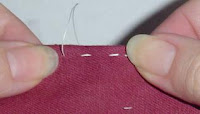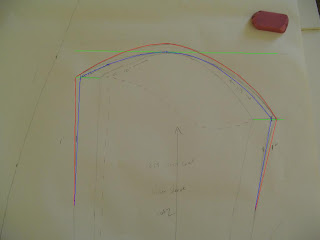Going by Historic Order...

 Mid 18th century shifts:
Mid 18th century shifts:
The first one has fitted sleeves & a scalloped flounce. It's made from a cotton/linen blend that is almost handkerchief weight, but not quite. I sent it's twin to CO for a very elegant lady.
Another sleeve type that I played with is the straight ruffle. Apparently this was worn a lot, by all classes, but I just don't like it as much as the flounce. Maybe if the sleeve was more fitted over the elbow?
Both of these have a semi-fitted sleeve vs. the 'easier' rectangle.
The next one I make will be long sleeved with a short ruffle. I also like the 1/2" band with a single button style.
I am avoiding draw strings on sleeves as I have never seen a historic reference for this pre-1780. It's a fire hazard and I highly recommend getting rid of any drawstrings that could dangle in your soup or double as a candle wick.
 Late 18th century wool shirt.
Late 18th century wool shirt.
This could be worn anywhere from mid-18th century to mid 1800's. Wool shirts, known in the reenacting community as "blanket shirts," were commonly worn by the working class (though never made from blankets!). The most common color was light brown, as it was easy to dye & re-dye, but any color could be worn. They were over-shirts for outdoor work... similar to sweat shirts or fleece jackets today.
I made this particular shirt for a friend of mine, who looks great in it, and I'd share if I could get his pictures off my e-mail!
The tricky thing about wool shirts is that most of the finishing work has to be by hand, because your machine will choke on all those layers. The cuffs & collar have to be hand finished, the neck gussets have to be top-stitched by hand, all the button holes must be hand sewn... the heart is always hand sewn... you might as well do all finishing by hand just to make it look right.
 1790-1800 Waistcoats
1790-1800 Waistcoats
These two wasitcoats are the same pattern for men of different heights. Strangely enough, they have the same waist measurement. I'm not sure this coincidence has ever happened before! The one gentleman is close to 6' tall, the other is about 5'5".
The blue waistcoat is made from fustian (cotton/linen blend) lined with cream fustian. This stuff frays like there's no tomorrow. Overlock, fray-check, stay stitch galore. But it's lovely to touch & stiff enough to not need interlining.
 The white is linen lined with self fabric. The collar will have to be starched, but then it will stand up perfectly.
The white is linen lined with self fabric. The collar will have to be starched, but then it will stand up perfectly.
Not sure I put that top button in the right place. It's right from the side, but looks kinda funny from the front. It's the right number...
This waistcoat is 1 of 4 garments in this order.
 1829 Waistcoat & shirt
1829 Waistcoat & shirt
2 of 5 garments...
This poor shirt has modeled for every waistcoat pictured here... It's a beautiful cream linen with a pleated front, which is kinda cool. And surprisingly easy to do... Really more pin tucks than pleats, but I'm not splitting hairs. The collar is extra wide & will stand up when starched. The cuffs are very wide too. Self-fabric wood-blank buttons.
The waistcoat is silk lined & backed with linen. It has a cotton interlining so the silk doesn't go all wonky.
The buttons are wood 4 holers covered with silk. My blanks took a hike somewhere... I'll find them next year!
This pattern is modified from the one above to be a late 1820's style. The collar is about 2" taller than the 1790 waistcoat & it's more fitted at the waist, with only 4 buttons in the front. I tried welted pockets, but they looked terrible with the silk. The outlines showed something fierce. I hate fake pockets, and have a feeling that this was what the originals had. I refuse to make fake pockets. So no pockets. Not even hidden ones.
Fortunately this gentleman is exactly the same size as my husband (what are the odds?) and I've been able to head off some potential oopses before cutting into customer fabric.
 Early Civil War Uniform, 1861-63
Early Civil War Uniform, 1861-63
(just to clarify, the American Civil War was from 1861-65).
This was my mother's project. This handsome gentleman is my former high school history teacher, Tom Cook. I learned more from him about troop movements in the Civil War than I ever cared to know.
He is one of our local historians and has written & published a book on Letchworth State Park... which is not on the bookshelf where it belongs, I will find the title & provide a link at a later date.
The jacket is a shell jacket made from navy blue wool that quickly dispatched every machine needle it met. The original color we discussed was Cadet Blue from West Point. This blue-gray color was abandoned early on because it was too similar to the Confederate Gray... if the term 'friendly fire' means anything to you. The sleeves are lined with brown cotton, the jacket itself is unlined as most of his tour-guide work is done in the summer. The cuffs come to the first knuckle... "the directions told her to do that!".. sorry, in-joke. I'm not sure what the reenactors do about sleeve length today.
The shirt is cotton with a pleated placket front & stand-up collar... and starched to within an inch of it's life.
The pants are sky blue wool, standard throughout the war. They are the right length when he has his shoes on.
All buttons are brass.
I think he got the cap off of e-bay.
So, this is a fraction of what's on the sewing table this month. The pile of stays parts is gradually becoming a pile of stays, the 1829 order is slowly getting done and the brain tan breeches that MUST be finished by the end of next week are literally inching towards looking like a garment a guy could wear.
Happy Sewing to all of you costumers in the New Year!



















































